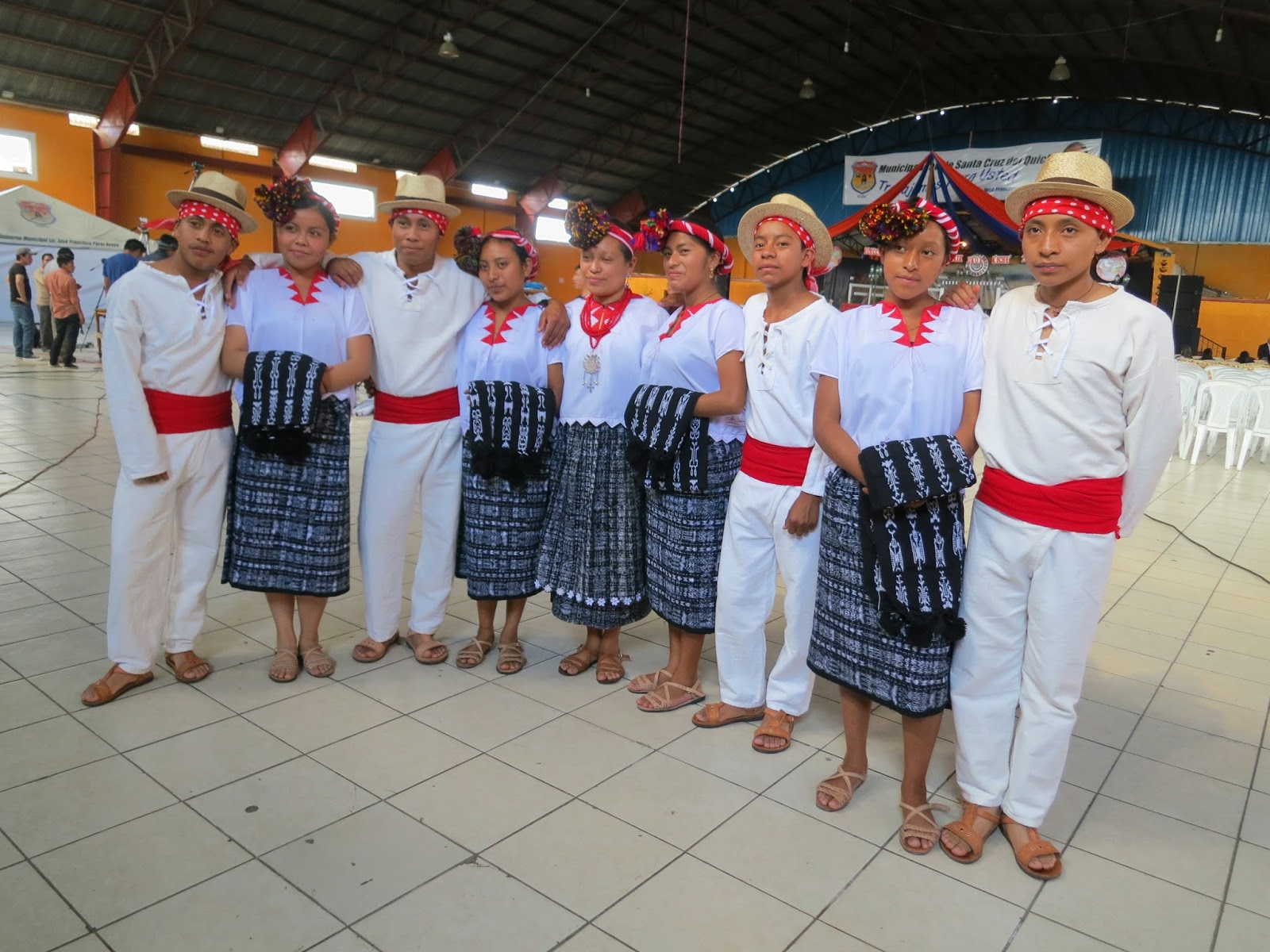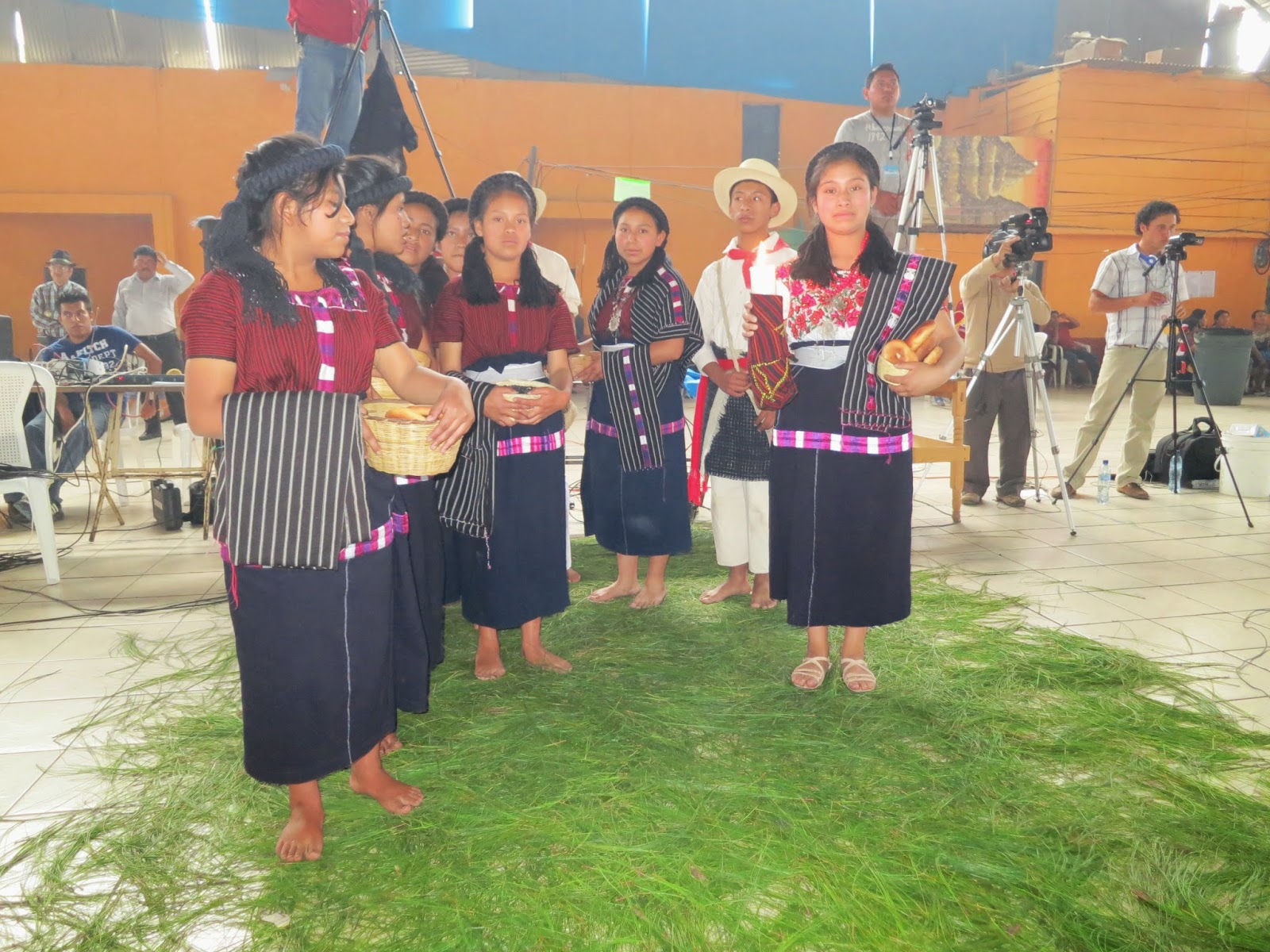The stage had been built out so that there was a runway in the middle, extending out into the audience, like a T, reaching at least half the length of the auditorium, and in the middle of the runway, two "arms" extending out on either side, so the entire arrangement was in the shape of two capital Fs, back to back (or a T with a smaller bar cutting through the stem). Along the edge of the stage were cutout photographs of women and a few men dressed in "traditional attire" from different parts of the country. At the farthest point of the runway, there were stairs, and a carpet of pine needles had been spread for about 10 feet beyond the end of the stairs -- the candidates would make a grand entrance, walking (or dancing) up the stars and along the runway until they reached the stage. Some technicians were busy trying to stretch one long piece of woven fabric - the kind of fabric that is usually used for a woman's corte -- across three benches that were separated by parts of a marimba. The central bench, parallel to the edge of the stage, was shorter, and on each side of it, a longer bench, at a slight angle, so that the entire set up was a very shallow and wide U. Meanwhile, other technicians were fiddling with microphones and cables.
But there was almost no one in the audience. The chairs were white plastic, the kind of "outdoor" chairs that are sold and used all over Guatemala. The backs of the first dozen or so rows of chairs were covered with pieces of gold cloth that were tied with elaborate bows; at first we sat down in the chairs with no cloth covering, since I thought maybe those seats were reserved for special guests, families of the candidates, and so forth. But there didn't seem to be any special protocol or anyone checking who was sitting where so we decided to move up. After we had been sitting for a while, I started to have doubts about when this was supposed to start, since the first announcement on the radio had said 6 p.m., but then there were several announcements of 3 p.m. Sandy went to check and she was told that it was going to start at 3, but it was nearly 3 when she went to ask. But there was nothing much to do: we weren't going to drive back to Chinique and then drive to Santa Cruz again.
I decided to take a walk around -- around the back and sides of the auditorium, there were groups of people who were accompanying the candidates. Part of the presentation is what is called an "estampa folclórica" -- literally, "a folkloric image" or a "folkloric representation". This is usually some kind of a tableau or dramatization, or a dance that represents -- in theory -- the culture of the specific municipality, or some aspect of "Maya culture and values". I use quotes here because these are, I think, highly idealized representations. This is an important part of the qualification, and some of the presentations were extremely elaborate, involving a dozen or more people. One could see the difference between the candidates who had some substantial support from their municipality or some other institution, and those who didn't.
 |
| The group from Nebaj |
The most elaborate estampas were the ones from San Andrés Sajcabajá and Chichicastenango. The candidate from San Andrés was accompanied by about 8 or 10 men, acting out a part of the procession that is done in that town during Holy Week, representing the via dolorosa and the via crucis.
 |
| The candidate from San Andres Sajcabajá. |
First, a figure wearing a crown of thorns with his arms strapped to a cross that he carried on his back. Then, some men carrying a much larger cross, on its side. Two men on their knees, with crowns of thorns on their heads and a smaller crown of thorns strapped to their backs. These men were all wearing white pants rolled up to their knees and their faces were draped with cloths (there were a few men wearing regular clothes who guided the blindfolded ones). They also carried small rugs that they laid down for the blindfolded men to crawl over; once the person had passed, the "guide" picked up the rug and moved forward and laid it down again.
 |
| San Andres Sajcabajá |
As we walked around before the event started, we saw groups posing for photographs, people arranging their costumes. There were a few reporters from national and local radio and television stations who were grabbing short interviews with the candidates. Lots of activity all around. Finally, close to 4 p.m., someone got on stage and announced that it would begin, and introduced the two MCs.
One was a woman I met briefly some years back, who was affiliated with the Academy of Maya Languages, the section for K'iche'. The man was from Chichicatenango. Both were given elaborate introductions with all of their professional qualifications. And then they introduced the local officials, the members of the judging panel, and then there were some musical numbers played by two different marimba groups.
Then the outgoing Ixkik Uk'u'x entered, accompanied by a young girl, and they took their place on the center bench of the stage. After that, the candidates were announced one by one, and each group made its way up the stairs and onto the platform. There were 14 candidates; I don't know enough about how the selection process takes place to know why not all of the municipalities of Quiché were represented (there are 22). As I noted above, many of the presentations were highly choreographed. Several involved fireworks, which are an important features of most patron saint feasts and Holy Week processions in Guatemala. Others were mostly dramatizations: one candidate presented a sociodrama about interfamilial violence and two others presented dramatizations of idealized scenes of everyday life: women working together to prepare traditional foods, and carry out everyday tasks. The MC offered frequent commentaries and explanations of what we were seeing; it's not clear whether the candidates provided the script for her.
The candidate from Zacualpa clearly had no support from her municipality, as she came out alone, bearing a platter and a basket with some wrapped parcels, and an older woman, undoubtedly her mother, helped her load up the things. She went to the midpoint of the platform and laid down the ceramic platter and started to unwrap the items she was carrying -- flowers, candles, some incense -- to prepare a small altar on the platter, which she then lit. Unfortunately, as she was carrying it up the stage, the platter cracked or she lost hold of it (it was hard to tell what happened) and it crashed to the stage, still aflame.
The entrances went on for a long time, as each of the 14 candidates took several minutes to enter. Then when all were seated, each had a turn to give her "message", first in a Maya language and then in Spanish. There was one candidate from Santa Maria Nebaj, which is in the Ixil region of el Quiche, so hers was in Ixil and Spanish, and all the others in K'iche' and Spanish (for that reason, presumably, one of the three judges was an Ixil woman). I was trying to position myself to take reasonably good photographs, which meant moving around a lot; there was no single good angle that worked, and my camera battery was dying so I didn't have the luxury of taking as many shots as I normally would (I had left the battery charger in the car the night before, but didn't know where it was, and only found it when we were on our way to Santa Cruz del Quiché).
The messages were on pretty predictable themes: respect for women, offering equal opportunity for girls' education; ending femicide; protecting the natural environment; maintaining pride in one's cultural identity; preserving Maya languages. The opening statement -- prefatory to the actual "message" -- is pretty formulaic. To the women and men, to the boys and girls, to the male elders and female elders, to the mayor of this municipality and his municipal corporation, to the selection committee and the qualifying judges, to my companions/fellow candidates, I wish you the best of this beautiful evening. I am XXX, and I bring you this message from the beautiful municipality of YYY.
Or, as a variation, the opening could be calling to the ancestral powers: Heart of the sky, heart of the sky, and then naming the people. This is usually accompanied by somewhat dramatic gestures skyward, earthward, and moving around the stage, microphone in hand. There is a kind of rhetorical and gestural similarity to all of these messages, regardless of content, including a similarity in cadence, pitch and tone of speech (that is, the literal presentation of self).
Following the messages, some more music and thanking sponsors while the judges deliberated and then announced the three finalists. Then questions to each of the finalists: not the same question to each but a question that was specific to the message that each had presented. Then more music and small gifts to each of the participants who was not a finalist while a final decision was reached. By this time it was nearly 9:30 -- over 5 hours since this had started. The children were getting very restless (even though their parents had taken them outside and bought food for them).
Finally, the judges announced their decision: the candidate from Patzité, whom we all agreed had given the best response to the question in the finalist round (she was actually the only one of the three who really addressed the specific question). Then the incoming and the outgoing Ixkik Uk'u'x each gave a little speech, and then some more awards (everyone involved thanks everyone else involved: the committee gave an award to the Mayor, the Mayor gave awards to the committee and the judges, and so forth). We were all pretty restless by that point so we didn't stay to watch the actual investiture, but picked up some tortillas at one of the stands that was still open, walked back to the car, and threw together a quick supper (mostly leftovers) when we got back home.









No comments:
Post a Comment